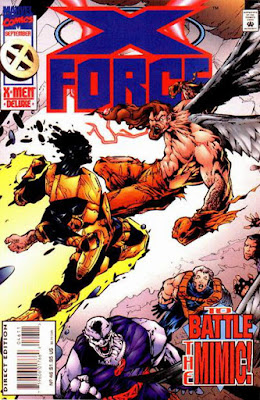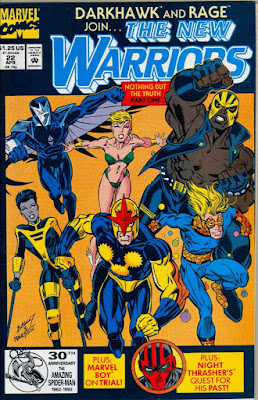Comics Beat posted an interesting article a few days ago about the importance of the artist in selling a comic. Incredibly, only 5% of retailers credited the artist as the most important thing in terms of selling a comic. I understand there's market forces at work there; comic book retailers have taken on the near-insane task of selling comic books, so their ideas are necessarily skewed by the need to "feed their family" and other similar considerations.
As someone who is entering the "comic book podcast" arena only a handful of years after most, I've already noticed that the two episodes that have gotten the most downloads thus far are the two with work by Grant Morrison and Alan Moore, two "names," that, not coincidentally, are not comic book artists. Not to pick on my co-hosts, but I cringe when introducing an episode by saying "Alan Moore's The Killing Joke," or similar pronouncements (although to be fair, in that episode we did explain that the story is really Brian Bolland's project more than Moore's).
The thing is, this mind-set is both backwards and toxic. Art is the most important thing in comic books. Period. It is the defining point of separation between comics and its bookstore neighbors in the sci-fi section.
Saturday, July 25, 2015
Wednesday, July 15, 2015
Review: X-Force #46
X-Force #46, “Behind Closed Doors,” Cover Date September, 1995
Written by Jeph Loeb, Penciled by Adam Pollina, Inked by Mark Pennington
Most people on the outside looking in at X-Force see it as proof of 90’s excess: it was Rob Liefeld’s pet project, the book that set all sorts of speculator records before being overshadowed by Jim Lee’s X-Men #1. Despite not having its own media presence, there was a line of action figures featuring endless variations of Cable, the team’s gun-toting mystery-man. While it’s true that the book as drawn and plotted by Rob Liefeld was the sort of big, bombastic action you’d expect from a book called “X-Force,” what a lot of people may not remember is that Liefeld’s tenure on the title was exceptionally brief.
X-Force had begun life as the New Mutants, the mid-80’s teen group created when Jim Shooter noticed that there were basically no more teens on the X-Men title (except Kitty), and while the team’s roster had changed in the wake of Cable taking over as leader, these were still characters that had existed in some form for several years. As I mentioned in my New Warriors review, I am a sucker for “teens growing up” stories, and X-Force is no exception. Personally, I found the leader-less “wandering around” phase far more interesting than the military strike team. So let’s get into it!
Written by Jeph Loeb, Penciled by Adam Pollina, Inked by Mark Pennington
Most people on the outside looking in at X-Force see it as proof of 90’s excess: it was Rob Liefeld’s pet project, the book that set all sorts of speculator records before being overshadowed by Jim Lee’s X-Men #1. Despite not having its own media presence, there was a line of action figures featuring endless variations of Cable, the team’s gun-toting mystery-man. While it’s true that the book as drawn and plotted by Rob Liefeld was the sort of big, bombastic action you’d expect from a book called “X-Force,” what a lot of people may not remember is that Liefeld’s tenure on the title was exceptionally brief.
X-Force had begun life as the New Mutants, the mid-80’s teen group created when Jim Shooter noticed that there were basically no more teens on the X-Men title (except Kitty), and while the team’s roster had changed in the wake of Cable taking over as leader, these were still characters that had existed in some form for several years. As I mentioned in my New Warriors review, I am a sucker for “teens growing up” stories, and X-Force is no exception. Personally, I found the leader-less “wandering around” phase far more interesting than the military strike team. So let’s get into it!
Friday, July 3, 2015
Review: New Warriors #22
New Warriors #22, "The Stolen Children, Nothing But the Truth Part 1" Cover Date April 1992
Written by Fabian Nicieza, Penciled by Mark Bagley, Inked by Larry Mahlstedt
I should preface this review by mentioning that I can't really be objective in my appreciation of the New Warriors. As I mentioned in a previous post, they were the first comic I read that I didn't learn about from TV, and I found the characters, who ranged from high school kids to college students to be pretty much the coolest. I know now that they're more or less Marvel's answer to the Teen Titans, but I love watching characters grow up, and that was the best part of the original series. It was also cool that I felt like I could follow all of the character's appearances, since they rarely popped up in other books. Of course, after years of growth, culminating in Justice and Firestar being added to the Avengers at the height of its resurgence in popularity, somebody at Marvel hit the reset button because the rest of the world wasn't aging, and things have been a bit dire for the team for the past 15 years or so as writers either play up nostalgia or take things in bizarre new directions. But taken on its own, Fabe and Bagley, two nearly unknowns at the time, managed to show everyone how good they could be and told a great, underrated story. Their run is available in hardcover if that's your thing, containing two years of the ongoing series, plus annuals and crossovers. Unfortunately, the book is not available on Marvel Unlimited.
Written by Fabian Nicieza, Penciled by Mark Bagley, Inked by Larry Mahlstedt
I should preface this review by mentioning that I can't really be objective in my appreciation of the New Warriors. As I mentioned in a previous post, they were the first comic I read that I didn't learn about from TV, and I found the characters, who ranged from high school kids to college students to be pretty much the coolest. I know now that they're more or less Marvel's answer to the Teen Titans, but I love watching characters grow up, and that was the best part of the original series. It was also cool that I felt like I could follow all of the character's appearances, since they rarely popped up in other books. Of course, after years of growth, culminating in Justice and Firestar being added to the Avengers at the height of its resurgence in popularity, somebody at Marvel hit the reset button because the rest of the world wasn't aging, and things have been a bit dire for the team for the past 15 years or so as writers either play up nostalgia or take things in bizarre new directions. But taken on its own, Fabe and Bagley, two nearly unknowns at the time, managed to show everyone how good they could be and told a great, underrated story. Their run is available in hardcover if that's your thing, containing two years of the ongoing series, plus annuals and crossovers. Unfortunately, the book is not available on Marvel Unlimited.
Subscribe to:
Comments (Atom)


